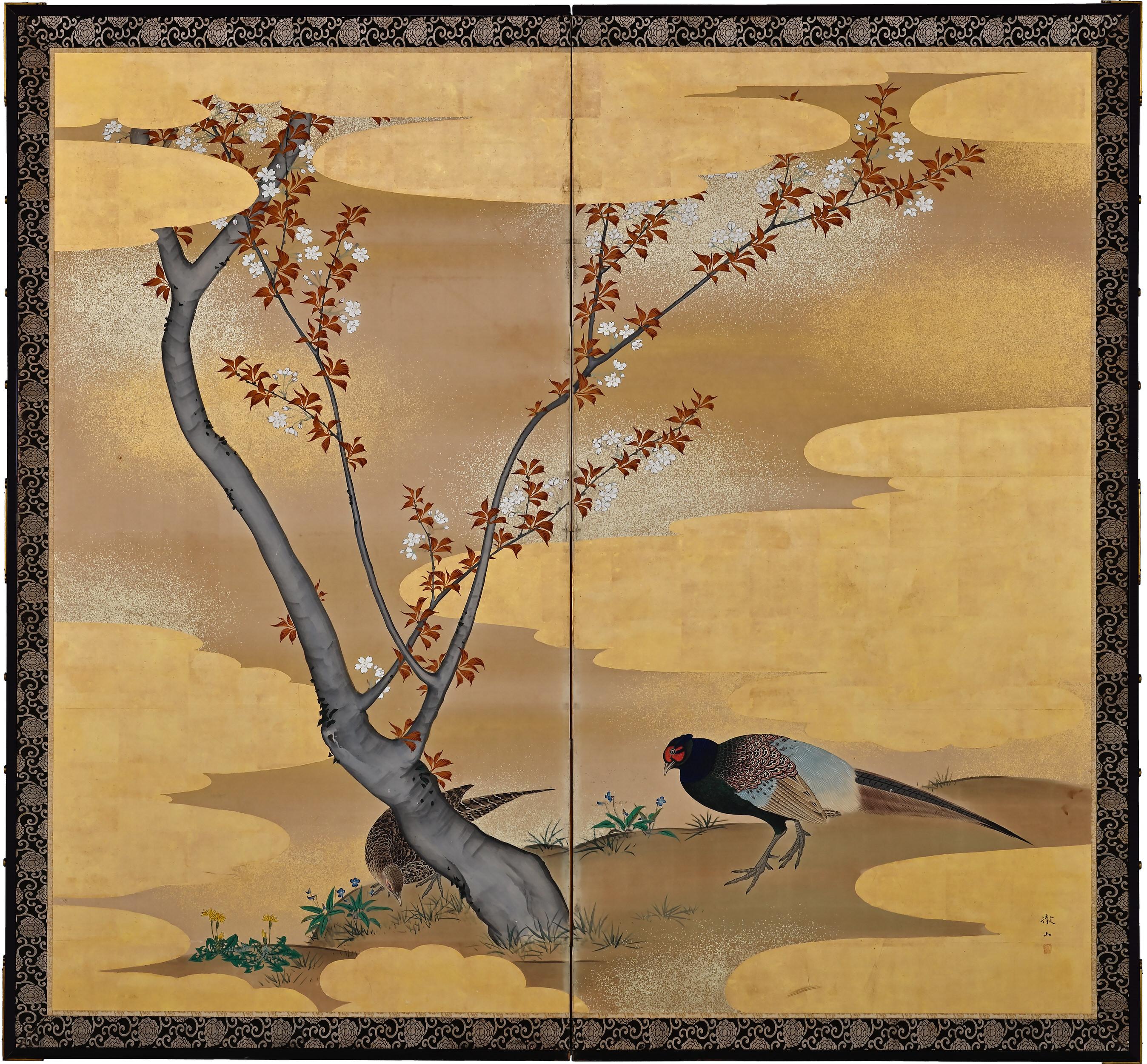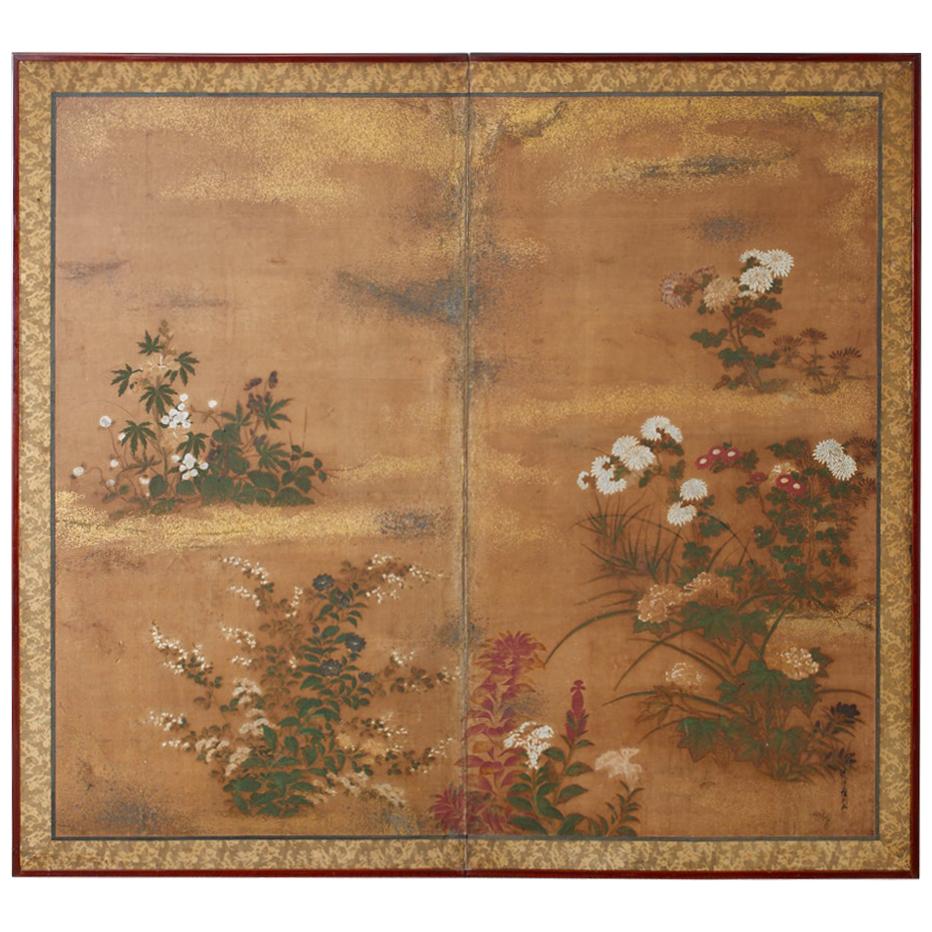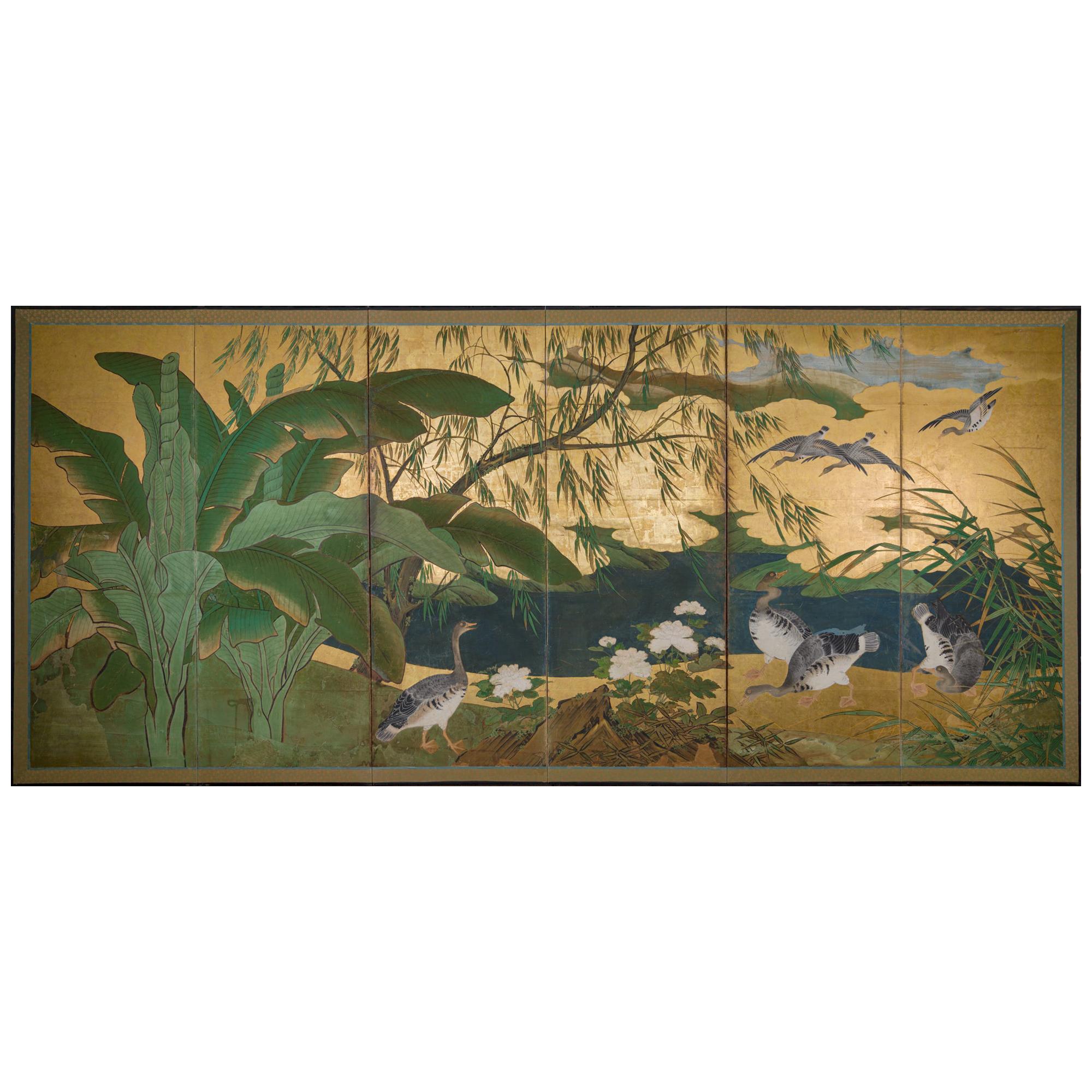Items Similar to Japanese Screen Painting, Early 19th Century, Autumn Flowers by Sakai Hoitsu
Want more images or videos?
Request additional images or videos from the seller
1 of 5
Japanese Screen Painting, Early 19th Century, Autumn Flowers by Sakai Hoitsu
About the Item
A two-fold Japanese screen by the Rimpa school artist Sakai Hoitsu (1761-1828), Japan, 19th century, Edo period.
This small Japanese folding screen painted by Sakai Hoitsu was originally designed as a pair of sliding doors for an alcove or tokonoma. The scene depicts an autumn vine weaving rhythmically through bellflowers (kikyo) and pampass grass (susuki). Kikyo and susuki are two of the celebrated seven grasses of autumn (aki no nanakusa) which were often mentioned in verses of the Manyoshu, the earliest collection of Japanese poetry and song. More than flowers of any other season, autumn grasses washed by rain and bent in the wind are thought to attain a beauty unsurpassed; many feel the same way regarding Hoitsu’s exquisite brushwork and graceful compositions.
A four-fold screen by Hoitsu utilising the almost identical composition is held in the collection of the Miho Museum, Shiga.
Born into the family of the feudal lords of Himeji castle, Sakai Hoitsu had a privileged and cultivated upbringing providing him the opportunity to study Noh drama, haiku poetry, tea-ceremony, music and painting. As was common during the Edo period, Hoitsu began his study of painting with the officially sanctioned Kano school, later receiving influence from and instruction in the contemporary Ukiyo-e, Maruyama-Shijo and Nagasaki styles. Taking tonsure as a monk in 1797 Hoitsu freed himself of his significant familial obligations and immersed himself in the study of the life and art of Ogata Korin (1658-1716). His attraction to Korin was inspired by the fact that a century earlier Hoitsu’s family had been among Korin’s chief patrons, and numerous masterpieces by Korin were preserved in their collection.
In 1815, 100 years after Korin’s death, Hoitsu published Korin Hyakuzu (One Hundred Paintings by Korin), woodblock print reproductions of paintings by the master. Besides honouring Korin in this way, he clearly traced the lineage of what would come to be known in a later age as the Rinpa (Rimpa) school. Hoitsu, while taking Korin’s works as his model, went on to create highly affecting works reflective of the refined tastes of his day.
In recent times the Rinpa (Rimpa) school, which Hoitsu played a pivotal role in developing, has become Japan’s most admired and celebrated school of art.
In 1972 an exhibition entitled ‘Rinpa’ was held to celebrate the 100th anniversary of the Tokyo National Museum.
Commenting on that exhibition the noted scholar James Cahill states “The world of Rinpa is not far from our everyday life. It simply transforms the everydayness into a thoroughly beautiful image. Of all the arts in the world, if one were to cite a decorative style that transcends the ‘simply decorative’ limit, it would be Rinpa. The delicacy, boldness, and impressiveness of Rinpa is a perfect match for works of religious or humanistic content demonstrating highly refined artistry.”
In 2008 the Tokyo National Museum held an exhibition titled ‘Treasures by Rinpa Masters - Inheritance and Innovation’ in which many works by Hoitsu were featured.
In 2011 to celebrate the 250th anniversary of Hoitsu’s birth a broad and scholarly exhibition titled ‘Sakai Hoitsu and Edo Rinpa’ was held at the Himeji City Museum of Art and the Chiba City Museum of Art.
In 2012 the Japan Society held the exhibition ‘Silver Wind: the Arts of Sakai Hoitsu’ in New York. The exhibited works were sourced predominantly from American collections.
In 2015 the Kyoto National Museum held the blockbuster exhibition ‘Rinpa - The Aesthetics of the Capital’. Works by Hoitsu formed a significant part of the exhibition.
Works by the artist can be found in the collections of: Asia Society, New York; Cleveland Museum of Art, Ohio; Etsuko and Joe Price Collection, USA; Feinberg Collection, USA; Gitter-Yellen Collection, USA; Hosomi Museum, Kyoto; Idemitsu Museum of Arts, Tokyo; Indianapolis Museum of Art, Indiana; Kyoto National Museum; Los Angeles County Museum of Art, California; Metropolitan Museum of Art, New York; Minneapolis Institute of Art, Minnesota; Mitsui Memorial Museum, Tokyo; MOA Museum of Art, Shizuoka; Museum of Fine Arts, Boston; Museum of Imperial Collections, Sannomaru Shozokan; Museum Yamato Bunkakan, Nara; National Gallery of Victoria, Australia; Nelson-Atkins Museum of Art, Missouri; New Orleans Museum of Art, Louisiana; Philadelphia Museum of Art, Pennsylvania; Seikado Bunko Art Museum, Tokyo; Smithsonian Museum of Art, Washington D.C.; Tokyo National Museum; Victoria and Albert Museum of Art, London; Worcester Art Museum, Massachusetts; Yamatane Museum of Art, Tokyo.
Dimensions:
Image H 13” x W 51” (32 cm x 129 cm)
Screen H 18” x W 56” (46 cm x 144 cm).
- Dimensions:Height: 18 in (45.72 cm)Width: 56 in (142.24 cm)Depth: 1 in (2.54 cm)
- Style:Edo (Of the Period)
- Materials and Techniques:
- Place of Origin:
- Period:
- Date of Manufacture:circa 1820
- Condition:Repaired. Refinished. Minor losses. Restored and remounted in Kyoto utilizing traditional craftsmen and materials.
- Seller Location:Kyoto, JP
- Reference Number:1stDibs: LU2472319236992
About the Seller
5.0
Recognized Seller
These prestigious sellers are industry leaders and represent the highest echelon for item quality and design.
Gold Seller
These expertly vetted sellers are highly rated and consistently exceed customer expectations.
Established in 2001
1stDibs seller since 2016
60 sales on 1stDibs
Typical response time: 6 hours
- ShippingRetrieving quote...Ships From: Kyoto, Japan
- Return PolicyA return for this item may be initiated within 10 days of delivery.
More From This SellerView All
- Early 19th Century Japanese Screen. Cherry Blossom & Pheasants by Mori TetsuzanLocated in Kyoto, JPMori Tetsuzan (1775-1841) Pheasants and Cherry Blossoms Two-fold Japanese screen. Ink, color, gofun, gold and silver on paper. A two-fold Japanese bir...Category
Antique Early 19th Century Japanese Edo Paintings and Screens
MaterialsGold Leaf
- 19th Century Japanese Scroll Painting, Birds & Flowers of the Four SeasonsLocated in Kyoto, JPBirds and flowers of the four seasons Early to mid-19th century Ink, pigment and gofun on silk Unidentified artist Signature: S...Category
Antique 1830s Japanese Edo Paintings and Screens
MaterialsSilk
- 19th Century Japanese Scroll Painting by Igarashi Chikusa, Poppies & ButterfliesLocated in Kyoto, JPPoppies & Butterflies Ink, pigment and gofun on silk Igarashi Chikusa (1774-1844) Signature: Chikusa Ran Zen Upper Seal: Ran Shuzen Lower Seal: Kyoho Dimensions: Scroll: H. 68” x W. 18” (172cm x 45cm) Image: H. 38.5’’ x W. 12.5’’ (98cm x 32cm) This composition shows elegant images of poppies and the butterflies that are inevitably drawn to them. It captures a momentary glimpse into a world both visually dazzling and startlingly realistic. The painting is infused with sensitivity and attention to seasonal change and weather conditions. The thin and fragile poppies are beautifully depicted with brilliant colors and the butterflies are similarly infused with life. The painting is on silk which requires extremely precise painting skills as no element once painted can be removed. Poppies were a favorite subject of Rinpa school artists through the ages. Originally they were somewhat abstracted but by the age of Sakai Hoitsu...Category
Antique Early 19th Century Japanese Edo Paintings and Screens
MaterialsSilk
- 19th Century Japanese Silk Painting by Kano Chikanobu, Phoenix & PaulowniaLocated in Kyoto, JPBirds & Flowers of the seasons Pheasants & Plum in Snow Unframed painting. Ink, pigment and gofun on silk Kano Chikanobu 1819-1888 Signature...Category
Antique Mid-19th Century Asian Edo Paintings and Screens
MaterialsSilk
- 19th Century Japanese Silk Painting by Kano Chikanobu, Turtles & AzaleaLocated in Kyoto, JPBirds & flowers of the seasons Pheasants & plum in snow Unframed painting. Ink, pigment and gofun on silk Kano Chikanobu 1819-1888 Signature...Category
Antique Mid-19th Century Asian Edo Paintings and Screens
MaterialsSilk
- 19th Century Japanese Silk Painting by Kano Chikanobu, Sparrows & NandinaLocated in Kyoto, JPBirds & flowers of the seasons Pheasants & plum in snow Unframed painting. Ink, pigment and gofun on silk Kano Chikanobu 1819-1888 Signature...Category
Antique Mid-19th Century Asian Edo Paintings and Screens
MaterialsSilk
You May Also Like
- Japanese Six Panel Screen with Hotei, Edo Period, Early 19th CenturyLocated in Austin, TXA delightful Japanese six panel painted paper screen featuring the beloved figure Hotei, Edo Period, early 19th century. Hotei, called Budai in China, and known as the Laughing Buddha or Fat Buddha in the West, is considered to be an emanation of Maitreya, the Buddha of the Future. In Japan, he also holds a special place as one of the Seven Lucky Gods, being the god of fortune, and protector of children. He is always portrayed as a mirthful and corpulent man, dressed in loose robes that show off his round belly. He carries a sack with him, said to be filled with treasure. As the protector of children, he is often portrayed with them playing on or around him, as he is here. The children portrayed in this screen are dressed in Chinese style clothing...Category
Antique Early 19th Century Japanese Edo Paintings and Screens
MaterialsSilk, Paper
- Japanese Edo Two-Panel Screen Flowers of AutumnLocated in Rio Vista, CAImpressive early 19th century Japanese Edo period two-panel screen featuring flowering plants and grasses of autumn. Painted in the Tosa School style Bunka Bunsei period or Ogosho pe...Category
Antique 19th Century Japanese Edo Paintings and Screens
MaterialsSilk, Wood, Paper
- Early 19th Century Japanese Six-Panel Screen, Tropical GardenLocated in Hudson, NYWith a banana leaf palm on the left, at water's edge with geese. Perhaps a scene from the southern islands. Mineral pigments on mulberry paper with gold leaf and a silk brocade border.Category
Antique Early 19th Century Japanese Paintings and Screens
MaterialsGold Leaf
- Edo Period 19th Century Japanese Folding Screen Six Panels Flowers on Gold LeafBy Rimpa SchoolLocated in Brescia, ITClouds of gold, water and many colorful flowers: Japanese six-panel folding screen by Rimpa School. Hand painted with rice mineral pigments and inks on rice paper and gold leaf.Category
Antique Early 19th Century Japanese Edo Paintings and Screens
MaterialsGold Leaf
- 19th Century Japanese Edo Six Panel Kano School Landscape ScreenLocated in Rio Vista, CALate Edo period 19th century Japanese six-panel landscape screen featuring a cypress tree over a flowering hibiscus with a pair of hototogisu birds. Kano school painted with ink and ...Category
Antique 19th Century Japanese Edo Paintings and Screens
MaterialsSilk, Wood, Paper
- Japanese Antique Ink Painting / 19th Century / Rare Chinese Character PaintingLocated in Sammu-shi, ChibaWe have a unique Japanese aesthetic sense. And only we can introduce unique items through our purchasing channels in Japan and the experience we have gained so far, in such a way that no one else can imitate. It is an ink painting written after the Meiji era. The biggest attraction of this work is that it uses Chinese characters to create paintings. To explain in detail, it is written here in Chinese characters as "un-ryu" . "Un" is a cloud and "ryu" is a dragon. These are embodied and drawn by comparing them to the meaning of Chinese characters. And the clouds depict the clouds hanging over the mountain, and the dragon depicts the climbing toward the mountain. Humorous paintings...Category
Antique Late 19th Century Japanese Edo Paintings
MaterialsAcrylic, Paper
Recently Viewed
View AllMore Ways To Browse
Small Screen
Flower Painting 19th
19th Century Flower Painting
Early California Furniture
Japanese Influence Furniture
Antique Japanese Screens
Antique Japanese Screen
Antique Silk Flowers
Japanese Screens Antique
Japanese Screen Antique
19th Century Screens Asia
Silk Painted Screen
19th Century Artist Model
Japanese Wood Painting
Silver Japanese Painting
19th Century Wood Screens
Antique Painting Decorative Arts
Screen Doors Used





